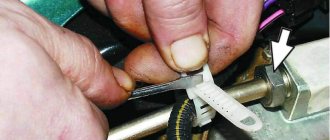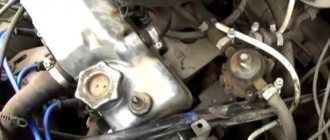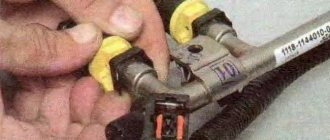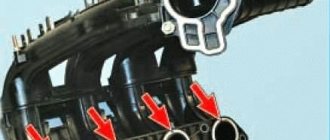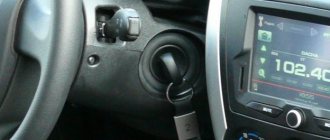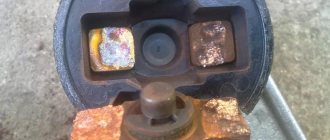As a rule, the true cause of the breakdown is revealed quite simply. And even a car owner who does not have deep knowledge of vehicle repair can easily correct problems that arise that are accompanied by incorrect behavior of his car.
In 50% of cases, the problem is due to the fact that the spark plugs simply do not produce a spark. This failure occurs as a result of 3 reasons:
- contacts become clogged;
- plaque forms along the entire contour of the candle;
- malfunction when supplying voltage to the spark plug.
However, the most popular is still black carbon deposits on the spark plugs, which prevents the spark from appearing or causes it to work periodically.
Tip: if the spark plug set malfunctions, you will hear a “triple” sound that is uncharacteristic of the engine. In this case, the car will jerk strongly while moving. As a result, the engine will either stall on its own, or you will need to turn it off and turn the ignition on again.
If you see dirt on the surface of the contacts, this indicates the need to replace a low-quality type of fuel or check the serviceability of the oil supply systems. It is the oil supply adjustment sensors that can splash the spark plugs with it if there is a problem. Also, oil that appears on a set of spark plugs may indicate serious damage to components in the engine cylinders. Be sure to check the engine at a car service center. Otherwise, further operation may lead to expensive replacement of jet rods and even the entire set of pistons.
If you systematically use low-quality gasoline samples, you may find a red-brown coating on the contour of the spark plug. In this case, cleaning will not help - it is better to immediately replace the entire set after a new refill. If you find that the car periodically turns off at full speed, but starts easily even with clean spark plugs, then the problem lies in the electrical wiring.
In this type of problem, 3 reasons may be involved:
- Poor contact with the terminals of the new battery;
- Detection of poor contact or breakdown along the entire length of high-voltage wires;
- The appearance of malfunctions in the generator or ignition coil system of the car.
If the problem lies in damp high-voltage wires, then it is best to replace them completely along with the battery contacts. If the terminals make poor contact, you need to carefully clean them with sandpaper and try to reconnect them. If the generator is found to be inoperable, the problem usually boils down to problems in the following parts:
- Broken timing belt;
- There is a malfunction inside the housing of the unit itself.
A problem with the generator is easily detected when the corresponding indicator on the dashboard turns on. In addition, if there is insufficient energy supply, the backlight of the on-board panel will gradually fade, and a set of other diagnostic sensors will show incorrect values.
Advice: if when you press the gas the car jerks, then stalls and cannot start, then the problem is related to the failure of the ignition coils. It is best to replace these parts in a car service using special equipment.
From the list of reasons that are directly related to the car engine, you need to move on to problems that arise in the fuel and air supply systems, as well as malfunctions of components responsible for exhaust gas removal. timing belt It is quite easy to know that the car stalls while driving due to the engine “choking” with the fuel mixture - during a long drive you will find a constantly switched on signal from the sensor responsible for this function.
Here the problem lies in low-quality fuel, which does not quickly “ignite” from the spark of the candles. It can also be caused by gasoline not meeting the requirements for the octane number specified in the vehicle specifications. If there are problems with fuel, the gas pedal will be pressed all the way, and the car will not begin to gain speed. In addition, the car will periodically stall when the clutch is engaged.
Another symptom indicating problems with fuel is the appearance of problems with the car after refueling. The problem is characterized by a rapid drop in engine power at full speed, as well as when constantly changing gears. The way out of the situation is to completely drain the bad fuel mixture, wash the engine and all the fuel system pipes.
Also, the car will constantly stall if there is an interruption in the supply of the fuel mixture. This may be due to contamination in the following system components:
- Dirt in the fuel filter;
- Problems with injector nozzles;
- Dirty throttle valves;
- Fuel pump power failure.
The main symptom of a malfunction of these parts is that there will be a gradual drop in the power of the car’s engine, after which the car will stall even after sharply pressing the gas pedal. If you do not release the clutch carefully when changing gears, this will also cause the engine to stall.
The contamination of the fuel filter and fuel pump can be judged by the unstable operation of the machine even during idling and during rapid braking (when the supply of the fuel mixture decreases). And if the performance of fuel filters can be easily established during an external inspection and eliminated by replacing them, then to detect other causes, you need a full-fledged computer diagnostics, which can only be carried out in a car service center.
Another reason for a stalled car associated with the operation of the fuel pump is boiling gasoline in the fuel pump. This happens mainly in hot weather when the car is moving slowly or standing on the highway in traffic jams. The car will start to stall while driving, but when you turn on the idle speed and press the clutch, it will start again.
If boiling occurs, it is better to stand in a traffic jam with the engine turned off and gradually cool the car. After 5-10 minutes, the car's operation will be stable again.
Advice: if you recently did a wheel alignment with your own hands on a VAZ-2107, then to cool the car, proceed as follows - throw a piece of cloth made of dense material over the fuel pump body, which you first moisten with cold water.
The Lada Kalina car engine stalls immediately after starting it
One of the reasons why the Kalina engine stalls immediately after starting is an insufficiently charged battery (frequent short trips in the cold season, the battery life is close to the end, long-term parking of the car without recharging the battery, etc.). The capacity of such a battery is enough for the starter to crank the engine at the frequency necessary to start it. But when the engine starts, the voltage at the battery terminals drops so much that the immobilizer, reacting to this voltage drop, blocks, through the computer, the supply of gasoline to the fuel rail by turning off the power to Kalina’s electric fuel pump. The residual gasoline pressure in the fuel rail is enough for 2-3 seconds of engine operation, after which it stalls due to lack of fuel.
Another reason for the Kalina engine to stop working immediately after starting it is the location of the electronic control unit, which is located under the interior heater housing. And in the event of even a small leak of antifreeze from the heater radiator, it gets onto the electronic unit and, if it is not properly sealed, penetrates inside, causing this malfunction.
A similar problem with starting the Kalina engine also appears when air is sucked into the pipe behind the flow meter. In this case, the flow meter provides incorrect information to the electronic control unit about the amount of air entering the engine cylinders. These data turn out to be underestimated, since part of the air goes into the cylinders, bypassing the flow meter, which sharply depletes the combustible mixture and the engine stalls.
Checking the serviceability of the throttle position sensor (TPS)
Our problem may be caused by a faulty DPSD. But it is this sensor that is tested last, when everything has been tried and tested. But in vain, it is easy to test, you can save a lot of time and money if you check this sensor. How to do it:
- This sensor is located on the throttle pipe, it is connected to the throttle axis. The sensor is secured with two screws. When removing the sensor, you should pay attention to the condition of the throttle valve, whether it is coked. If yes, then there will be the same symptoms as with problems with the sensor. However, the sensor can be checked without removing it.
- To do this, you need to measure the voltage at the DPSD terminals when you turn on the ignition, and it should not exceed 0.7 V.
- Next, open the throttle using the plastic sector, and then measure the voltage again. It must be at least 4 V.
- Next, check the voltage at the DPZD terminals when the damper moves. It should not change; abrupt changes indicate a sensor malfunction.
Having found out that the sensor is faulty, it should be replaced. On the VAZ-2110, 2 types of DPZD are installed - film-resistive and non-contact. The first is designed for 55 thousand mileage, the second is unlimited, but much more expensive than the first.
Well, dear friends, we have presented some tips for servicing your car yourself. I hope you find them useful.
Source
The Lada Kalina car engine stalls when idling
One of the components that causes the Kalina engine to stop idling is the idle speed regulator (IAC), which becomes clogged with sticky dirt. As a result, its needle remains in the closed position, and the combustible mixture stops flowing into the engine cylinders.
In order to remove the IAC from its installation site and clean the needle using a special solvent or at least alcohol (liquid should not get inside), you must first warm up the engine, then disconnect the wires from it and immediately turn off the engine. In this case, the IAC needle (after removing it) will stick out above the plane of the connector and will be easier to clean. In this way, you can reanimate the IAC, but if this does not help, then it will have to be replaced. There are cases when voltage is simply not supplied to the IAC; in this case, you will have to check the contacts in the plug connectors and the integrity of the wires going to it.
The second problem with the engine idling may be the throttle sensor, which fails due to fairly rapid wear of the resistive layer of the variable resistor, since this layer does not like moisture and dust.
Ignition system
Pay attention to the condition of the ignition module (article on module repair here), high-voltage wires and spark plugs. If there are traces of corrosion, melting on their surface, or there are cracks on the body, this will only mean that each of the above elements will require replacement, since they cannot be repaired or corrected. In order to correctly approach the issue of choosing spark plugs for the VAZ-2112, you can read this article.
First we check the wires, and then the spark plugs.
Why does the engine start and immediately stall?
The engine starts and immediately stalls, this is one of the most common problems that arise when operating cars. And it doesn’t matter whether it’s a foreign car or a domestic car, this situation can happen to absolutely any car.
When the engine starts and immediately stalls, many drivers begin to panic a little, because not every driver can immediately identify this malfunction. Pulling on wires, pipes, kicking the car wheel out of helplessness, as a rule, does not produce results. Usually the car will start after a while, and then the situation may repeat itself.
Why the engine starts and immediately stalls, the reason and answer to this can be various malfunctions specific to a particular car model, ranging from a malfunction of the VVT-i valve, or rather due to its clogging, and ending with the burning of the contacts of the fuel pump relay, which Happens often on Honda cars.
It is worth noting that recommendations are given here not for complete dummies, but for those who can already independently perform simple work to identify the malfunction and eliminate it. For people who do not understand anything about these issues, it is better to immediately go to a car service center, and if the engine starts and immediately begins to stall, and this is repeated several times without success, call a tow truck.
As a rule, the main reason that the engine starts and immediately begins to stall, or does not start at all, is a malfunction of the idle air control. This is especially true on domestic cars.
How can you diagnose a malfunction of the idle speed control?
1. You stopped for 5 minutes after a long trip, naturally the engine is hot. After this, you try to start the engine, but the engine does not start or starts and immediately stalls. Even if the engine starts, the normal idle speed is not set immediately, but only after pressing the gas pedal more than once.
2. The same situation can occur on a cold engine. The first time the engine starts and immediately stalls, but the second time it runs fine.
3. Whatever the engine is, hot or cold, it starts only when the gas pedal is pressed down.
4. The situation is the same as in point 3, but the accelerator pedal must be held constantly until the engine warms up or the car starts moving.
5. You braked sharply and the car suddenly stalled; when you restart, the idle speed remains within normal limits.
6. Suspension of idle speed in the inflated range from 1500 to 2000 revolutions and only after re-gassing they return to normal values.
Therefore, if your car’s engine starts and immediately begins to stall, try immediately flushing the throttle assembly and idle air control. If this doesn't help, just replace the IAC and that's it.
The next reason that the engine starts and immediately stalls is a faulty injector. Since most modern cars have a forced fuel injection system, this malfunction is very common.
What should not be allowed when operating fuel-injected cars.
1. Do not disconnect the battery while the engine is running.
2. Try to play with lighting as little as possible, and in general, handle food as carefully as possible. Injection cars are very sensitive to such manipulations.
3. Try not to disconnect the ground on the car. Although I turn off the mains in my car in winter if I don’t drive for a long time, and so far I have not noticed any discomfort in operation, although many experts say that it is possible to erase information in the computer. I just try to let the car idle for up to 3 minutes when starting the engine.
This is interesting: How does a car starter work?
4. Injector-injected cars are not very fond of charging and starting devices, since when they are used, the voltage jumps significantly and the ECU can burn out.
5. If a neutralizer is provided in the design of the car, then try not to start the car by towing or pushing it down a hill, as unburned fuel is formed, which, if it gets into the neutralizer, can spontaneously ignite.
6. Do not allow water to get into the injector; this is strictly contraindicated. To do this, change fuel filters in a timely manner and fill with high-quality gasoline.
7. If your car is equipped with an L-probe and a neutralizer, then think about whether you should risk using leaded gasoline. When using such gasoline, the L-probe, in addition to the fact that it itself can quickly break down, it will transmit incorrect data to the ECU, indicating a large amount of oxygen, and this, to put it mildly, is not very good, as it can lead to local overheating of the engine .
So, we return again to our problem, the engine starts and immediately stalls or does not start at all. The most deplorable situation is that the engine will not start at all. First of all, you need to maintain composure and not scold the car itself. Only after this, we calmly begin to find out the reason why the engine does not start.
Do not allow the battery to be severely discharged by pointlessly rotating the engine crankshaft, the energy will still be useful to you, but where you will charge the battery if you are far from home is the question. Although for the electronic unit itself 8 Volts will be quite enough. But, of course, they won’t be enough for the starter.
Also be sure to check.
1. How does the fuel pump work and is there any fuel in the tank?
2. Is there ignition?
3. Is the engine crankshaft timing sensor functioning?
4. Are the injectors out of order, although the failure of several injectors at once is too much, this happens very rarely.
5. The ECU is working. But this device also fails very rarely.
Now let's go into more detail
1. The performance of the fuel pump, of course, is determined by its sound. If there is no sound, then check the wiring and provide 12 V supply to it. Pay attention to the pressure in the fuel system, it should be within 2 - 3 bar while the pump is running. If the fuel supply is stopped, the pressure in the system does not drop immediately. If the pressure drops sharply and there are no fuel leaks, then pay attention to the fuel pressure regulator. At least it can be silenced for a short time.
2. Check the ignition. To avoid burning the ECU, the spark plug must be connected to ground as best as possible.
3. When checking the synchronization sensor, first of all, pay attention to the integrity of the wiring and its shielding.
4. As for the ECU, you need to try to move all possible connections. There is a high probability that something has come loose somewhere.
5. Pay attention to whether the Check Engine light is on. If it lights up, then all is not lost and the ECU is still working. You need to know that it is not yet possible on VAZ cars without a tester to find out the error code and identify the location of the fault.
6. If a suspiciously large number of error codes are displayed, then you need to pay attention not to the sensors, but to the fact that some part of your car has completely disappeared.
7. You should also pay attention to the performance of the crankshaft synchronization sensor and the performance of the injector control system. But all this requires a special tester, and rarely does anyone carry this device with them in their car. Yes, and it is advisable for specialists to perform such work.
8. But many people can check the voltage in the network. As a rule, when the engine is running it should be 14 V, when starting the engine 8 V, and when the engine is not running 12.5 V.
9. Be sure to check the integrity of the camshaft drive belt and pulley. It's not difficult to do.
10. And the last hope. We disconnect everything possible from the ECU (electronic control unit), only leaving the crankshaft synchronization sensor. But again, if you know what you're doing. If you don't know, it's better not to interfere.
The following situation: the engine still starts, but it is problematic.
1. Check the air filter for clogging. If you have completely forgotten where it is, then everything is clear. Go ahead, buy a new filter, or at least clean the old one.
2. Check the fuel pump as described above.
3. When starting the engine, depress the clutch, this will make starting easier.
4. Pay attention to what temperature the coolant sensor shows and what it actually is. Deviations should be within 5, 6 degrees.
5. Again, check the voltage in the car network. What voltage should be, see above, paragraph 8.
6. Pay attention to the quality of the fuel. Ask yourself the question, “Where did I refuel today?”
7. Move all possible connectors. It’s corny, but sometimes it helps.
8. We look at the camshaft drive belt.
These are the simplest actions that are available to many drivers. To conduct a more detailed diagnosis of the cause of poor engine starting, of course, it is better to contact a car service center. Professional equipment and devices will already be used there.
To summarize, we can say that when the engine starts and immediately stalls, the reason for this is not so easy to identify. The problem of this phenomenon can be located both deep in the car itself and on its surface (just move the wires). Therefore, if simple actions accessible to an ordinary driver do not bring results, the problem is not solved and is constantly repeated, then you cannot do without a car service. Definitely, this requires a professional approach and the availability of professional equipment.
Testing the mass air flow sensor (MAF)
Let us remind you what we are talking about - VAZ-2110 8-valve injector: the speed drops and stalls. A reasonable question arises: what to do? If the reason is not the IAC, then it is worth testing the mass air flow sensor. Here are some recommendations on how to do this:
- Disconnect the sensor connector from the on-board system. The controller that controls the engine will operate in emergency mode, but for short testing this is not fatal. If your car runs much faster, then the problem is most likely in the mass air flow sensor. It's time to clean it.
- Replace the sensor with a working one, and then see how the engine works. There are improvements, which means you need to either clean or replace your own mass air flow sensor.
- It also makes sense to inspect the air intake; to do this, you need to remove the mounting clamp and carefully inspect the inside of the air intake, there should be no condensation or oil there. If any are found, then it will have to be cleaned with special means.
- You can also test the mass air flow sensor using a multimeter. To do this, you need to switch the multimeter to voltmeter mode and set it to 2. The sensor has 2 wires - yellow and green. Yellow transmits a signal to the controller, and green transmits a signal to ground. When the ignition is turned on, we take measurements between these two wires. The engine should not be running. If the readings are in the range of 1.01-1.02, then the sensor is in perfect order. Readings in the range of 1.02-1.03 – it’s time to clean the sensor. And if the indicators go off scale to 1.04, then it’s time to get a new sensor.
Now we have figured out the main symptoms of a malfunction of the mass air flow sensor; neither testing nor troubleshooting is particularly difficult. It is quite possible to cope without after-sales service.
Kalina does not start the first time
Today's post will be devoted to such a problem as the unsuccessful start of the Kalina engine. If your car does not start the first time, then this already indicates a certain problem that leads to this result.
There can be a great many reasons why the engine does not start immediately, and it is unlikely that it will even be possible to consider everything within the confines of this article. But still, we will try to provide below a list of the main problems that may be involved in poor starting of the Kalina engine.
- Low fuel pressure in the rail . After a long period of parking, the pressure in the fuel rail decreases. And to start the engine, normal operation of the fuel pump is required to create the very pressure that is necessary. If the pump no longer copes with its task 100%, then this may be the reason that the engine does not start the first time. The second time the pump pumps more pressure into the ramp, and Kalina starts right away. This was one of the possible problems; below we will consider other options.
- Ignition coil malfunction . This can be applied to both 8 and 16 valve engines. If the coil begins to act up, then it is possible that the first launch attempts may be unsuccessful. This can be especially true in damp weather or in winter at sub-zero temperatures. A clear example of such a problem was discussed in the blog some time ago, and you can read about it here.
- Crankshaft sensor malfunction . This happens extremely rarely, and in most cases, sensor failure immediately leads to the fact that the engine does not start and there is no spark. But sometimes, if the crankshaft position sensor is faulty, your Kalina may have difficulty starting: the second or third time.
- Failure of the IAC or TPS . If problems arise with these sensors, interruptions in engine operation and even poor starting may occur. The BC cannot always show errors in these sensors, and the most ideal option is to install known-good elements to check their functionality.
- Low-quality gasoline can also cause poor starting. To verify this from your own experience, it is enough to drive at least a day on 92 gasoline - on a 16-valve Kalina.
- Start blocking by immobilizer . I think many have heard about this and some owners have even encountered it. In this case, you can first retrain the key, and if this does not help, contact a specialist for repair or shutdown.
This is interesting: Drawings of the brackets for the additional rear shock absorber of the VAZ 2106
As mentioned above, you can list the reasons for a very long time. If you are the owner of Kalina and have encountered such problems, you can unsubscribe in the comments, as well as provide ways to solve this or that problem!
Lada Kalina starts and immediately stalls. Cause and solution to the problem.
I'm talking about a glitch with the Lada Kalina. Like a car that doesn’t want to start on a dead battery. The reason is the immobilizer. View to all Kalinovodas. A very scary situation. There is also a problem with starting it by lighting it from another car. Immobilizer lags on AvtoVAZ Lada Kalina.
Aidyn QazaQ Khany 6 개월전
like you friend. changed the battery and started.
Sasha Malina 6 개월전
I've been racking my brains for half a year, and here it's just you
Machinist 10 개월전
What the hell does this have to do with the battery? My battery was dead. After a day of standing, the starter could barely turn, but when it caught hold, it started and rumbled steadily. Now there is another grant, the starter turns vigorously even after a week of standing. But with the onset of cold weather, glitches began when cold - it starts, rumbles for 1-2 seconds and stalls, but the second time everything is ok. This is 100% not about Akuma. It seems to me that the dog has rummaged around with one of the relays, the gasoline relay is surrendering to me. This is due to a power loss during startup, causing the relay to turn off the fuel pump.
Machinist 8 개월전
Mikhail Velikorodny is good.
Mikhail Velikorodny 8 개월전
Driver I have the same problem! If you find a way, let me know! Thank you in advance !
777jj555zlo
100% right!! low voltage and the standard emobilizer will work, it turns off or prevents the car from starting, clean the ground on the contact body, lubricate the terminals, charge the battery
SEARCH ENGINE 63RU
did you try to start it in emergency mode? so at least you can get home)


